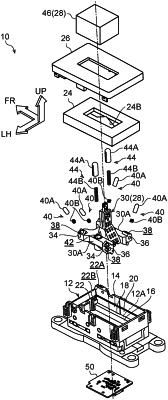| CPC F16H 63/3013 (2013.01) [F16H 59/0204 (2013.01); F16H 59/08 (2013.01); F16H 59/10 (2013.01); F16H 2061/243 (2013.01)] | 9 Claims |

|
1. A shift device comprising:
a shift body that is provided with a sliding portion and a restricted portion, and that, as a result of the shift body, the sliding portion, and the restricted portion being moved slidingly along a length direction, causes a shift position to be altered;
a slid-against portion that is formed from a softer material than the sliding portion so as to be more deformable than the sliding portion, and along which the sliding portion is moved slidingly as a result of the shift body being moved slidingly;
a restricting portion that is formed from a softer material than the restricted portion so as to be more deformable than the restricted portion, that is provided integrally with the slid-against portion, and that restricts a sliding motion of the restricted portion so that a sliding motion of the shift body is restricted, and
a supporting body that supports the shift body, and with which the slid-against portion and the restricting portion are integrally molded,
wherein at least one reduced-rigidity portion provided at the restricting portion is a stop abutment including a recessed portion, and
wherein a dimension of the recessed portion in a restricting width direction of the restricting portion is less than a dimension of the restricted portion in the restricting width direction of the restricting portion so that the restricted portion abuts against a face of the restricting portion in which the recessed portion is opened so that the sliding motion of the restricted portion is restricted.
|